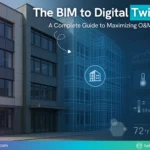How is BIM central to construction technology disruption?
January 14, 2020

Construction used to be a traditional industry where things moved at a slow pace. But no more. Innovation and trends in the construction industry have kept pace with the rise in demand for new advancements. Technological advancements are now driving the construction industry forward at a pace not seen earlier. For instance, drones make it possible to study and map a site easily, faster, and at a lower cost. Smartphones and tablets make communications a breeze. Digital applications and other software-driven solutions make it possible to map out even the nitty-gritty of a project. Even the use of robots is seemingly within easy reach. New technological advances are continually changing the construction industry. Technology seems set to cause unimagined disruption in the construction industry.
This change is enabling us to build taller, stronger, and more energy-efficient structures. Technology has also made construction sites safer and workers more efficient. This has led to an increase in productivity, improved collaboration, and coordination, and easier handling of more complex projects. Today, new advancements in construction are being developed at a faster pace. But it is also true that Building Information Modeling could well be the most vital element driving most or all of these technological innovations.
A few of the technologies that are moulding today’s construction site and the role of BIM are listed below:
1. AI & Machine Learning: Construction firms are currently using data to settle on better choices, increase productivity, improve safety on construction sites and reduce risks. With artificial intelligence (AI) and machine learning systems, firms can turn the information they have gathered over the years to predict future results on projects and gain an advantage when estimating and offering on construction ventures. AI also improves worker efficiency and productivity by reducing the amount of time wasted, moving about the site to retrieve instruments, materials, and tools to perform specific tasks. But where will these technologies get extensive, current, and strategic data about the structure to be impactful? BIM is the obvious place to turn to.
In fact, when you extend the discussion to Big Data and Analytics, the value becomes even greater. Construction firms are turning to analytics to get data-driven insights that help them improve efficiencies as well as effectiveness. Analytics is helping them understand trends in work that has already happened and make predictions about work that could be coming up. In that scenario too, the comprehensive, current, and coherent information available from the BIM models can amplify the impact of the Big Data and Analytics initiatives.
2. Robots & drones: Robots are also being utilized to monitor job-site progress with real-time, vital information to improve work productivity. Drones and rovers equipped with high-definition cameras are being used to click pictures and scan the construction site every day with accuracy. Drones are already in use at construction sites. Drones can survey entire sites in a shorter span which helps to save much time, which also leads to saving a great deal in labour costs as it requires less human involvement. But these technologies are expensive. Their use must be strategically directed. Every action must be carefully planned. It would be hard to achieve that level of accurate direction without basing it all on an accurate and updated BIM model. In return, the model can also be enriched with the latest and most accurate information captured by the drones. There is synergy all around.
3. Cloud & Mobile Technology: Today, mobile devices are ubiquitous. Most software solutions are also primed to utilize cloud technology. The coming together of these two factors ensure that it is always easy to use and operate cloud-based software from anyplace, at any time. The advantages of cloud-based software include the inexpensive storage of limitless amounts of data that can be accessed instantly. This is making rich project information available to all members of the project team. But when married to the power of BIM this combination can deliver unprecedented value. Think of how this can improve collaboration between teams on-site, for instance. The BIM model can become the commonly accessible, single version of the truth all the teams refer to and base their plans on. This will ensure smooth work, fewer clashes, better work planning, and smarter resolution of issues.
4. Augmented & Virtual Reality: Virtual Reality provides workers with exposure to situations such as confined spaces or working at height in a safe and protected environment. Virtual reality (VR) is beneficial in providing construction site safety training and equipment operator training. Augmented reality (AR) is another innovative technology that can significantly improve safety on the construction site. There are various ways that AR can be deployed on construction sites. It assists in developing a more detailed safety plan and provides training on heavy equipment. When allied with robust BIM models the AR and VR strategies can become much richer, more detailed, nuanced, and impactful. That will ensure that the AR/VR driven training can set the information the workers are being exposed to in a specific context. This will make the training much more meaningful and impactful.
We know that BIM helps to visualize the finished structure with all its segments and systems before the construction even begins. Potential issues and difficulties can be recognized and fixed to avoid physical errors, damages, and costly revisions. Designers and contractors can benefit from the technology by incorporating it right from the design stage. BIM generates a digital representation of structures in 3D models to facilitate better cooperation. This leads to better design and development of buildings. The kind of vivid visualization made possible by BIM helps in better collaboration and communication.
Even with these innovative technologies contributing to the success of the construction industry, it’s clear that one technique that retains relevance in these technological advancements is BIM.















